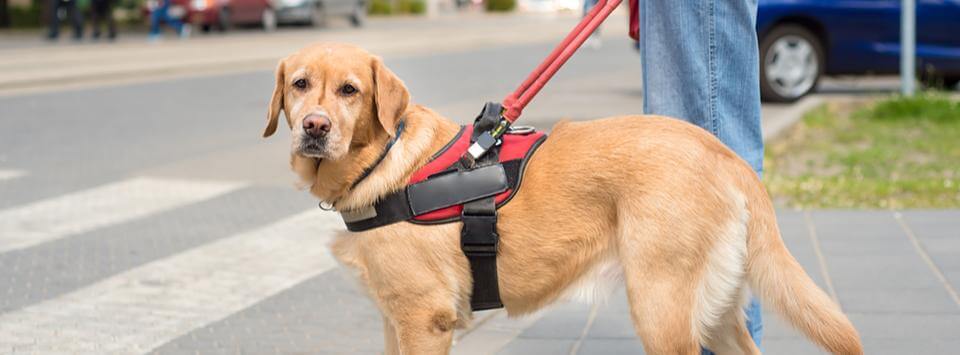Service animals and emotional support animals are used by people with disabilities for many reasons. A person with diabetes might use a service dog to alert them to low or high blood sugar events, for example, while someone who suffers from anxiety might benefit from having an emotional support animal to help them stay calm.
If you suffer from a disability and think you could benefit from having a service animal or emotional support animal, read on to learn more about these special assistants.
The Difference between Service Animals and Emotional Support Animals
You might have heard others use the terms service animals and emotional support animals interchangeably. Although service animals and emotional support animals both assist humans and occasionally perform some of the same tasks, there are differences between the 2.
Service Animals
According to the Americans with Disabilities Act, dogs are the only species that can work as service animals; however, the new regulations contain a specific provision that also covers miniature horses.
- Service animals are specifically trained to perform tasks for people with disabilities.
- They are not considered pets. Instead, they are considered working animals that must be trained to perform tasks related to their handler’s disability.
- These animals may also provide emotional support and comfort, but this is not the main task that they are used for.
Emotional Support Animals
Unlike service animals, emotional support animals do not have to be trained to perform specific tasks. Instead, they can simply be used to provide emotional support and comfort. Additionally, all different types of animals can be used as emotional support animals.
Even though dogs and cats are common, there are people who have snakes, hamsters, birds, and other animals as emotional support animals as well. If you have a disability and could benefit from a working animal that can assist you with tasks in your daily life, then you might qualify for a service animal.
If you suffer from anxiety, depression, or a similar disorder and you’re looking for an animal that can help provide emotional support, then an emotional support animal might be a better fit for you.
Registering a Service or Emotional Support Animal
Registering a Service Animal
If you already have a dog, you may be interested in registering your pet as a service animal. Unfortunately, animals that have already been kept as pets generally cannot be trained to be certified service animals.
You may be able to use your current pet as an emotional support animal, however. Typically, service animals start learning their jobs from a young age. Service dogs and miniature horses must undergo significant socialization and training before they are fit to do their jobs.
You can talk to your doctor about whether or not having a service animal will be a good fit for you. Then, your doctor can help by writing up the appropriate paperwork. You may want to work with one of the many organizations that train service animals.
According to the Americans with Disabilities Act, service animals do not have to be professionally trained, so you can train the animal yourself if you prefer. A service animal does not have to wear a special harness or other identifying gear.
In some cases, a harness can even get in the way of the service animal performing their job. However, a harness can help avoid confusion in public places. In any case, business owners and other individuals are not allowed to ask you for documentation related to your service animal.
Registering an Emotional Support Animal
If you have or are planning to have emotional support animal, the process is a little different. Your doctor can write an emotional support animal letter, which is all that is legally required.
There are emotional support animal registries that you can use to register your animal if you want to, but you must still have an ESA letter from a doctor.
Since emotional support animals are not covered by the Americans with Disabilities Act, business owners are not required to allow you to bring the animal into places of business where animals are not allowed.
The Fair Housing Act does protect individuals with emotional support animals, however, so you may be able to secure a rental with an emotional support animal, even if pets are not allowed. Having an ESA letter can make it possible for you to travel on airplanes with your emotional support animal without the same restrictions and fees as you would pay for a pet.
Tips for Flying with a Service or Emotional Support Animal

First, be aware that service animals have more legal protections than emotional support animals. If you have a service animal, then airlines must allow you to travel with that animal to remain compliant with the Americans with Disabilities Act.
It is also illegal for the airline to charge you additional fees for bringing your service animal on the flight, as long as the animal fits in your lap, at your feet, or under your seat. Unlike the Americans with Disabilities Act, the Air Carrier Access Act does allow for emotional support animals on airplanes.
Again, you cannot be charged additional fees. However, many airlines have restrictions about the types of emotional support animals that can be brought on flights.
You will need a letter from your doctor stating that you need to bring your emotional support animal with you when traveling by air. This letter must be turned in to the airline at least 48 hours before your flight.
If you need additional information about flying with your emotional support animal, contact the airline that you will be flying with.
Additional tips for flying with service animals and emotional support animals include the following:
- Take your animal to the vet prior to traveling to ensure they’re up to date on all of their vaccinations and in good health.
- Be sure to pack all of your animal’s treats, food, medications, and grooming products.
- Don’t feed your animal immediately before the flight to avoid possible stomach issues.
- Aim to arrive at the airport earlier than you would if you were flying alone to ensure a smooth trip.
- If the airline requires you to keep your animal in a kennel, make sure to label the outside with your name, contact information, and a photo of the animal.









